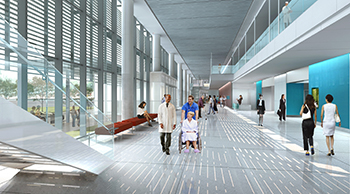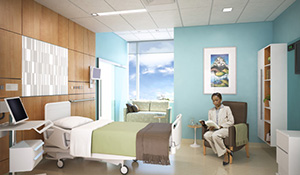Eskenazi Hospital to Open
 INDIANAPOLIS — The new $754 million Wishard Health Services Sidney and Lois Eskenazi Hospital is a product of the extensive collaboration of a team of more than 40 design firms, architects, landscape architects, engineers and consultants aimed at providing a groundbreaking health care facility to the community of Indianapolis.
INDIANAPOLIS — The new $754 million Wishard Health Services Sidney and Lois Eskenazi Hospital is a product of the extensive collaboration of a team of more than 40 design firms, architects, landscape architects, engineers and consultants aimed at providing a groundbreaking health care facility to the community of Indianapolis.
HOK, headquartered in St. Louis, led the architects on the project. Architects on the project, which are locally based in the Indianapolis area, include A2S04, Blackburn Architects, BSA Life Structures, PlatinumEarth, Ratio Architects and Synthesis Inc.
“The result of the collaboration, we believe, will establish a new benchmark for healthcare design in the city, state and beyond,” said Paul Strohm, AIA, LEED AP, director of health care at HOK. “The experience by all individual team members will propel the next phase of innovation in health care design with the benefit being improved health for the citizens of our communities.”
The 37-acre health care campus includes a 315-bed hospital, 17 operating rooms, four international labs, 12 labor and delivery rooms, a 90-bed treatment room emergency department with a 16-bed clinical decision unit, an Adult Level I Trauma Center and more than 200 ambulatory clinic exam rooms.
The hospital features a dynamic design from the exterior to the interior. The exterior façade contains tall decorative fins that shimmer colorful light. The exterior design, Strohm said, reflects the idealized internal organization of campus buildings.
“A unifying language of expression using planes and frames provides interest and distinction for each campus building,” Strohm said. “The buildings are sculptural and timeless, providing a key guide for future civic design in the city.”
 The design of the outdoor entry commons was specified by the executive leadership team to be an open and inviting environment that would function as a community space, said Mark Banholzer, AIA, LEED AP, regional design director for health care interior architecture with HOK.
The design of the outdoor entry commons was specified by the executive leadership team to be an open and inviting environment that would function as a community space, said Mark Banholzer, AIA, LEED AP, regional design director for health care interior architecture with HOK.
The interior design showcases the Eskenazi Health Permanent Art Collection with several newly commissioned art pieces, which also serve as wayfinding tools. A variety of textures and colors can be found throughout the interior, as well as a spiraling wooden sculpture suspended from the ceiling of the main concourse.
“The design of the entry lobby extends the exterior language to the interior. The stone lobby wall reflects materials, patterns and textures exhibited throughout the entry commons,” Banholzer said. “Modular white glass panels create a backdrop for the entry lobby, echoing the simple white frame of the exterior and creating an identifiable landmark that expresses the internal organizing spine of the building.”
Windows used in every patient room and throughout the interior provide views of the garden, park or downtown skyline.
“The modest interior environment becomes a platform to view the expansive Indianapolis skyline and landscape," Banholzer said.
 The project on target to achieve LEED Gold status, which has been a goal from the onset of the project, said Mara Baum, LEED AP, health care sustainable design leader with HOK. The campus will use 100 percent fresh air in all outpatient clinic spaces, and green roofs will manage stormwater and harvest rainwater.
The project on target to achieve LEED Gold status, which has been a goal from the onset of the project, said Mara Baum, LEED AP, health care sustainable design leader with HOK. The campus will use 100 percent fresh air in all outpatient clinic spaces, and green roofs will manage stormwater and harvest rainwater.
“The LEED system asks us to think differently about issues that we may not be accustomed to addressing in health care facilities,” Baum said. “To achieve significant energy and water savings, we have to think beyond the conventional systems.”
One unique sustainable feature of Eskenazi hospital is the 5,000-square-foot Sky Farm. Patients and staff are welcome to grow food on the rooftop vegetable garden and take in views of the city.
“Functionally, the Eskenazi Health Sky Farm highlights healthy eating and wellness concepts for patients while providing them with an opportunity to be out in nature and experience beautiful views of the city,” Strohm said. “The garden also provides additional sustainability benefits for stormwater management, improved air quality and overall energy reduction.”
The 1.3 million-square-foot campus will open for patients beginning Dec. 7.
